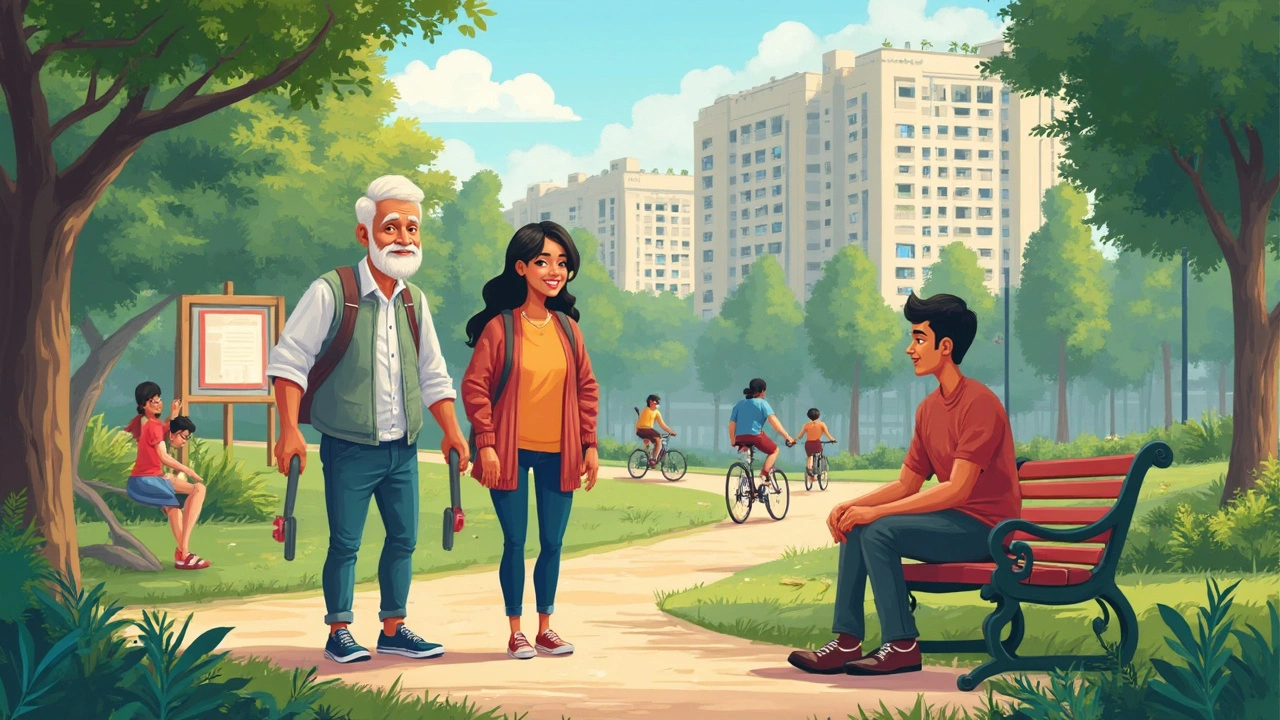Want to move somewhere that won’t destroy your wallet but still feels like a place you actually want to be? You’re not the only one. High rent, grocery bills, and surprise fees can drain your bank account no matter how “nice” the neighborhood. Here’s a little secret: some of the most comfortable places to live also cost a lot less than you think. And no, you don’t need to live in the middle of nowhere or put up with boring suburbs to get there.
Affordable living is about more than just cheap rent. You want parks close by, good food, fast WiFi, and neighbors who actually say hi. It’s about stretching your money further—getting a bigger, brighter apartment or a better social life—without stress every month when bills roll in.
Curious about where these unicorn locations are hiding? You’ll find real numbers, not just guesses, and see how people make it work in places locals love. From colorful small towns in Eastern Europe to lively mid-sized cities in Mexico, the options might surprise you. Ready to see where your next home could be?
- What Makes a Place Cheap AND Nice?
- Top Cities Worldwide for Affordable Living
- Hidden Gems: Underrated Affordable Towns
- Cost Breakdown: Rent, Groceries & WiFi
- Smart Tips for Picking Your Next Home
What Makes a Place Cheap AND Nice?
Most people think you have to pick one—either a low price or a great place to live—but that's just not true. Lots of cities around the world give you both, if you know what to look for. The trick is figuring out what matters most beyond just rent prices.
When talking about the cheapest places to live, it’s not just the sticker price of an apartment. There’s a stack of things that keep your monthly costs down while still letting you enjoy your day-to-day life:
- Affordable Housing: Cities where rent is less than 25% of the average salary are a sweet spot. For example, in Tbilisi, Georgia, you can rent a modern one-bedroom for under $400 a month.
- Low Cost of Living: Groceries, eating out, public transport, and health insurance can swing your budget up or down fast. In places like Chiang Mai, Thailand, a solid meal at a local spot costs just $2–$3.
- Good Infrastructure: Fast internet, reliable electricity, and safe drinking water aren’t “extras”—they’re must-haves. Many affordable spots now have 50 Mbps+ speeds for under $20/month.
- Safe and Social: If your savings mean you can’t go out safely, what’s the point? Look for spots with low crime rates and a welcoming vibe.
- Walkability and Public Transport: Saving money on cars or cabs makes a huge difference, and walking five minutes to pick up food or chat at a café is priceless.
Want the numbers behind it? Check this snapshot of monthly living costs (for a single person, USD) in popular cities:
| City | Rent (1BR) | Groceries | Internet | Transport Pass |
|---|---|---|---|---|
| Medellín, Colombia | $360 | $120 | $20 | $30 |
| Bucharest, Romania | $410 | $140 | $13 | $18 |
| Da Nang, Vietnam | $270 | $110 | $11 | $9 |
Notice the numbers—rent is just the start. The best value hits when all these categories make sense together. If you can save on groceries, enjoy your neighborhood, and get WiFi that actually works, you’ve got the magic combo.
Top Cities Worldwide for Affordable Living
Finding that sweet spot—the city that’s affordable but actually has stuff to do—can feel tricky. But let’s break down a few of the top picks where your paycheck really goes the distance.
Affordable housing is the big selling point in Chiang Mai, Thailand. Here, rent for a modern one-bedroom apartment in the city center often stays under $400 a month. Eating out is cheaper than cooking in some cases—you can grab a delicious local meal for around $2. The expat community is buzzing, WiFi is fast, and locals are friendly, making it popular for remote workers and digital nomads.
If you prefer Europe, head to Budapest, Hungary. It’s got nightlife, grand old buildings, hot springs, and surprisingly low costs. Locals pay about $500 to $700 for central apartments, and monthly transport passes go for less than $30. You get all the perks of city living with a smaller bill.
Medellín, Colombia, once famous for the wrong reasons, has reinvented itself as one of South America’s most livable cities. The weather stays around 72°F (22°C) all year. Rent in safe, lively neighborhoods often lands below $500 a month. Cafes, green parks, and a solid metro system make daily life easy and low-stress.
Eastern Europe has another gem: Sofia, Bulgaria. It’s not flashy, but you get fast internet, tasty street food, and rent that rarely breaks $400 in the city. Sofia is also part of the EU, so traveling around Europe from here is simple and cheap.
Looking closer to the US? Mérida, Mexico stands out for its safety, colonial vibe, and affordable healthcare. Monthly rent in a good area can stay under $350. Utilities, public transport, and fresh produce barely dent your budget, and the local food scene always keeps things interesting.
Curious what makes these cities click? They all mix affordable rent, good amenities, and a community vibe that just feels right—which explains why people from all over the world move in and decide to stay.

Hidden Gems: Underrated Affordable Towns
Everyone knows about obvious cheap spots like Chiang Mai or Lisbon, but there are places flying under the radar where you can live well for less. These are the kind of towns you see in a travel video and think, ‘I had no idea people lived this well for so little.’ Local prices, low stress, and lots of friendly faces—these towns deserve a shoutout.
Take Cuenca, Ecuador. Rent for a decent apartment in the central area averages $400/month, and you can walk everywhere. The fresh food markets are packed every day, and expats say they feel at home fast. In Eastern Europe, Plovdiv in Bulgaria keeps showing up among the cheapest places to live if you want history and culture but at a fraction of big city prices. People routinely pay less than $300/month for rent, and a meal out hovers around $6.
Let’s look at a few unsung heroes around the world that get you a laid-back lifestyle without the big city costs:
- George, South Africa: Surrounded by mountains and beaches, it’s safe, small, and rent is well below $350/month. Locals say you get a good mix of modern amenities and natural beauty.
- Dalat, Vietnam: Known for cool weather and French-era architecture, rent for a western-style apartment sits around $250/month, and good local meals cost about $1.50.
- Puebla, Mexico: A lively college town packed with amazing food, historic buildings, and rent starting at $290/month for a nice one-bedroom apartment.
Here’s a quick glance at how these spots stack up cost-wise, so you see how far your money goes:
| Town | Average Rent (1BR, city center) | Meal Out | Internet (monthly) |
|---|---|---|---|
| Cuenca, Ecuador | $400 | $4 | $22 |
| Plovdiv, Bulgaria | $280 | $6 | $13 |
| George, South Africa | $340 | $5 | $40 |
| Dalat, Vietnam | $250 | $1.50 | $10 |
| Puebla, Mexico | $290 | $5 | $20 |
If you want to skip crowds, cut down your cost of living, and not give up what you love, give these underrated towns a look. Just remember: research local visa rules, see what kind of jobs or remote work options exist, and try to visit first if you can.
Cost Breakdown: Rent, Groceries & WiFi
Here’s where things get real. It’s not enough to know a place is "affordable"—you need the numbers. Let’s break down the actual monthly costs in some of the cheapest places to live that people always talk about. The chart below covers a standard one-bedroom apartment, groceries for one, and an unlimited WiFi plan, converted to US dollars, as of spring 2025.
| City | Rent (1BR, city center) | Groceries (monthly, 1 person) | WiFi (unlimited/month) |
|---|---|---|---|
| Chiang Mai, Thailand | $310 | $120 | $20 |
| Queretaro, Mexico | $420 | $140 | $21 |
| Cluj-Napoca, Romania | $430 | $160 | $12 |
| Lisbon, Portugal | $1,050 | $250 | $36 |
| Lviv, Ukraine | $350 | $100 | $7 |
Pretty wild, right? While Lisbon is much more expensive, you can live well in places like Chiang Mai or Lviv for a fraction of what a big Western city costs. You could rent a place in downtown Chiang Mai, eat fresh fruit every day, and still have cash for cafes and fun.
- Rent is usually your biggest bill. If you share a flat, that number drops even further.
- Groceries depend on if you eat local foods or stick to imported stuff. Local markets save you serious money.
- WiFi is surprisingly affordable in most of these cities—honestly, sometimes faster and cheaper than in the US.
One thing people forget: some towns give you the low costs but also lots of little extras, like bike share programs or free public WiFi. And don’t forget to factor in stuff like transportation costs or health insurance, since those can mess with your budget if you overlook them.

Smart Tips for Picking Your Next Home
So, how do you actually pick the right spot that keeps both your bank account and your mood happy? It’s more than just scanning rental sites or chasing the lowest price. Here’s what you should be looking out for if you’re serious about finding the affordable housing sweet spot:
- Check cost of living, but look closer. Rent is a big piece, but don’t ignore things like health insurance, transportation, groceries, and even how much a cup of coffee is. Sites like Numbeo and Expatistan show breakdowns for cities worldwide, giving you a feel for actual daily costs.
- Dive into the vibe. Look up walkability scores, crime rates, and how easy it is to find medical care. Cities with good public parks or active community Facebook groups tend to have friendlier, safer neighborhoods.
- Internet and phone coverage isn’t just geek stuff. Bad WiFi is a mood killer, especially if you work remotely. Ask locals, don’t just trust the ads from internet companies.
- Visit (even just virtually) before committing. Google Street View lets you wander the streets, so you can see if buildings look rundown or if the area seems lively. You can also join local expat or digital nomad Facebook groups for honest info about life there.
- Healthcare matters. Emergency room visits abroad can be cheap—or crazy expensive. Double-check what typical check-ups or medicine costs, and see if you need insurance upgrades.
Here’s a quick breakdown comparing some popular spots with their average monthly cost of living (as of early 2025):
| City | Rent (1BR) | Groceries | Internet | Transport Pass |
|---|---|---|---|---|
| Chiang Mai, Thailand | $270 | $170 | $17 | $28 |
| Brno, Czech Republic | $460 | $220 | $23 | $22 |
| Queretaro, Mexico | $360 | $190 | $23 | $15 |
| Cluj-Napoca, Romania | $390 | $210 | $13 | $14 |
| Valencia, Spain | $710 | $270 | $35 | $42 |
If you’re weighing your options, answer these three questions: Does the city fit your budget with room to spare? Are basic needs (like reliable Internet and good healthcare) easy to access? Would you enjoy living there day-to-day, not just on paper?
Start with one or two destinations, check out short-term rental platforms first, and don’t believe everything you see on Instagram. Real life beats glossy photos. When in doubt, ask expats and locals—they love sharing what works (and what to avoid) in their hometowns.
